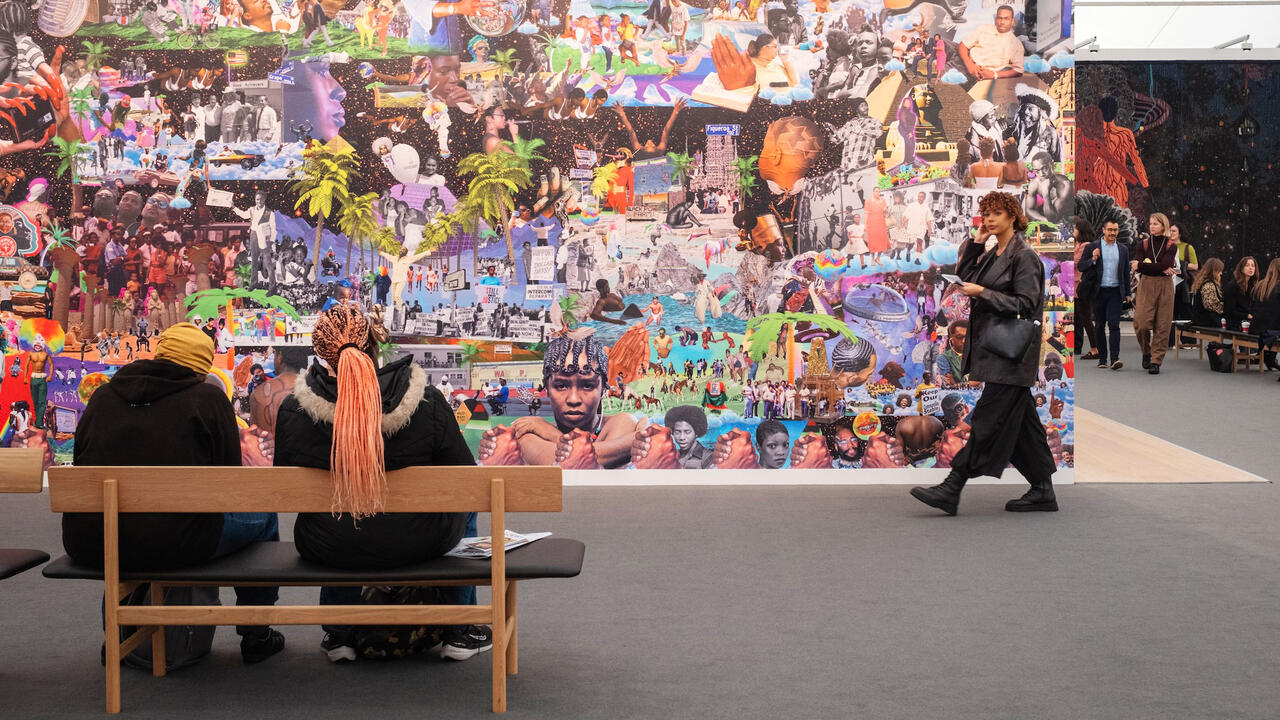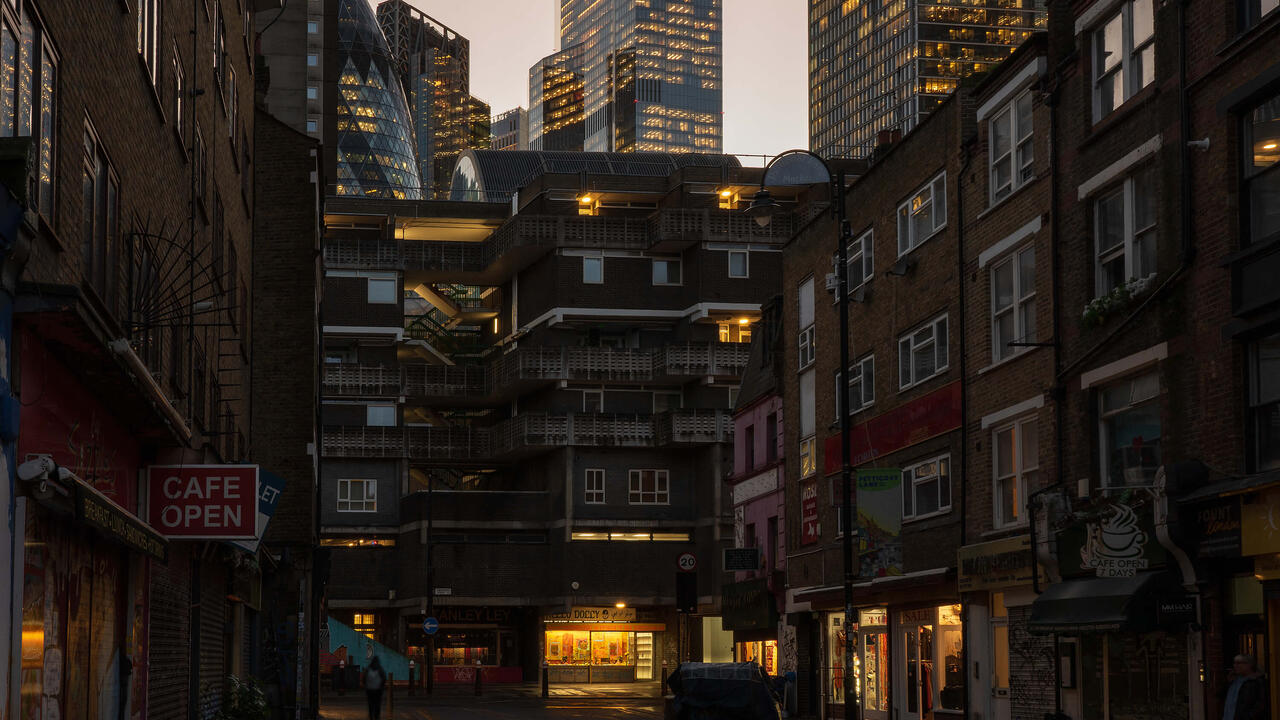Under Pressure
Bodily and technological extremes in the sculptures of Yngve Holen
Bodily and technological extremes in the sculptures of Yngve Holen

There exists a tradition of artwork employing mass-produced and commercial goods that, ever since its inception with Duchamp’s ‘readymade’, has challenged the preconception that art should bear traces of the artist’s hand. After various recapitulations via Dada, Pop and Minimalism, this tradition has now become a dominant form of object-making. Over the past decade, the readymade has been resuscitated by a new generation of artists who repurpose commercial and corporate objects – here symbolizing sophistication in product creation that serves corporate economic interest. Whether a sculpture incorporating running sneakers (Your mothers maiden name, 2013, after the password verification prompt) or an ophidian grouping of scooter headlights, Hater Headlight (2015) – both by Yngve Holen – artwork today made with mass-produced products necessarily bears some relationship to capitalism’s processes of commodification and novelty. As such, these objects are often either embraced or dismissed as too knowing, too cynical, too complicit or as harbingers of ‘cool’.
As if an oppositional force, in very recent years the popularity of art objects that employ the look of the ‘handmade’ – intimate, unknowing, and crafted – has also skyrocketed. Since Carolyn Christov-Bakargiev’s well-received 2012 dOCUMENTA (13) and Massimiliano Gioni’s outsider-art-inflected 2013 edition of the Biennale di Venezia, many works have been brought to the fore in which the maker’s hand was imprinted on the final object. This conveyed a back-to-the-roots ‘labour time’, a proximity and genuine hold on the body that comes only through touch. Adding to the handmade style aura of authenticity is its mode of circulation: handmade works are traditionally given as gifts or sold by artisans at a relatively low price. This re-appearance of handmade style in the form of products that do not bear the same trace of capitalistic novelty might lead one to conclude that ceramics are the new ‘post-Internet’, that dead artists are the new ‘89+’, and that ‘outsider’ is the new ‘Berlin’. Yet the relationship of handmade objects to those works employing the methods and commodities of mass production is, in fact, dialectical; as capitalism would have it, these works are already subsumed into the art market and sold at art market prices.

Perhaps, then, a wholesale rejection of the contemporary corporate readymade as a drag-and-drop commodity is premature. As we look toward an era marked by a renewed, very warranted interest in questions of gender and identity, our traditional distinctions about the body are also evolving. Further, as the ways in which we routinely experience our bodies has expanded to technological and bionic spheres, it may be that our existing aesthetic strategies to contemplate and visualize the body are, in fact, insufficient. For this, we might need not only the aesthetics of the handmade, but the correlation of this aesthetic of the body in relation to technological progress.
The work of Norwegian-born, Berlin-based artist Yngve Holen is almost entirely made of corporate-produced objects yet focuses almost entirely on the human body. More specifically, Holen re-purposes CT scanners, electric water boilers and car headlights as products that symbolize the body’s extensions and take it to extremes – whether advanced tools for medical imaging repurposed as minimal sculptures, or early projects for which Holen dissected water kettles to reveal (while killing) their functionality. Titled 'Parasagittal Brain' (2011–2013), for this series he cleanly split water-related objects such as tea kettles – also cut using a water-jet process – which ended up looking like brains replete with folds and convolutions. To some extent, the result dealt with soothing anxiety with knowledge (a plastic ‘brain’) – or perhaps the utter uselessness of such ‘knowledge’ in the face of physical changes of state.
Trained as an architect in Vienna, Holen – a graduate of Frankfurt’s Städelschule – was first taught to consider designed space and its psychic and spatial powers over the body. As an artist today, Holen applies this focus to the often-unnoticed, discrete but wholly critical design of quotidian objects, such as how washing machines are sized so they can fit through every home doorway. Holen creates mostly sculptures, recently accompanied by magazine-style publications, and has of late focused on themes such as airplane flight operations, pornography and plastic surgery – all industries where the body is transported, cut into, stretched, pumped full, compressed and squeezed.

bodies and we look like a
softball team. We all
match. We're all working on
the same people
2015
Plastic, car paint, steel
177 x 185 x 36.5 cm
courtesy: the artist, Neue
Alte Brücke, Frankfurt am Main.
Holen’s series 'Extended Operations' (2013–2014) lays a piece of ‘meat’ – actually a veined piece of marble sculpted after a 3D scan of actual meat – on a stage element that recalls a gurney. The first work in that series was shown initially at 'Extended Operations' at Rogaland Kunstsenter, Stavanger in 2013, and then in the group exhibition 'Speculations on Anonymous Materials' (2013) at the Fridericianum, Kassel. The carpeted surfaces of that series resembles an airplane floor with an emergency floor path system, or perhaps – from a distance – a black tarmac. The black surfaces of these works are sometimes topped with bird-control spikes, which themselves evoke medical-grade titanium pins. Further parsing the work’s title and references, the term ‘extended operations’ refers to the aviation acronym ETOPS, Extended-range Twin-engine Operational Performance Standards.
The ‘ETOPS’ acronym, used by aviation industry professionals, refers to the permitted flight paths of twin-engine aircraft, as determined by International Civil Aviation Organization. These paths are dependent upon the plane’s proximity to an airport should one of its engines fail, and the calculation of the possible distance covered by an aircraft with a single operational engine. ETOPS particularly details the flight path of twin-engine aircraft – as opposed to three- or four-engine aircraft – between diversion airfields, such as oceans where there are no intermediate airports. As such, the acronym ETOPS is also rumored to stand for ‘Engines Turn or Passengers Swim’, a decidedly darker acronym suggesting that should both engines fail, flight passengers would be jettisoned into the ocean. The term ETOPS makes rounds through Holen’s practice, acting as the title for, currently, two different bodies of work and a magazine whose two current issues have been presented by Holen for exhibitions at Rogaland Kunstsenter and Galerie Neu.
How can we peer into the body to understand its inner processes without actually touching it?
ETOPS the magazine emulates in-flight magazines yet its sole issues were both produced as collateral material for Holen’s exhibitions. ETOPS II, released for his 2015 exhibition 'World of Hope' at Galerie Neu in Berlin and for 'World of Hope II', Neue Alte Brücke, Frankfurt – shown alongside CT scanner works – includes interviews with a nameless plastic surgeon and a porn agent, and contains no photos of Holen’s work (aside from a cover image taken by Holen), so it can’t really be considered an exhibition catalogue. In fact, the publication contains to no images at all spare its covers: an image of Dakota Skye, an extremely young-looking, adult porn actress, atop the hood of a red Mustang convertible; and the back cover, a stock- looking image of a Siemens Somatom Force CT scanner. The first ETOPS, published for Holen’s Rogaland Kunstsenter exhibition, culled air travel imagery posted on Instagram and featured an interview with a GermanWings pilot, name redacted – just as the porn agent and plastic surgeon’s names were later redacted in ETOPS II.
ETOPS is an accompanying publication to Holen’s sculptural-based projects – as a magazine, it is an example of the serial production methods that interest Holen – but the research-intensive, interview-style magazine does much to illuminate Holen’s thematic conerns, more generally, at the intersection of the body and technology. All of those individuals interviewed in ETOPS work in industries that are at the forefront of pushing the body to extremes: the surgically modified and pornographic body in particular, which often go hand-in-hand, and which are enacted mostly through the female body. One might discern a compulsive epistemophilia (love of knowing) associated with Holen’s ongoing investigations into flight. Yet fear of flying and interest in the mechanics of planes are often related to anxiety about the body and the sublime modern experiences through which we regularly put our bodies – flying over oceans, being thrust through tunnels in steel contraptions, being shot with invasive radiation to image our insides, subjected to an interplay of regulation and surveillance in spaces such as airports. One might – when considering Holen’s airplane-themed works – recall Martha Rosler’s 'In the Place of the Public: Airport Series' (1983–ongoing) which also looks to airports as a strange interpolation of private and public social space constructed to communicate citizen control. The psychology of semi-public interiors and surveillance are also concerns of Holen’s, as evidenced by his recent exhibition 'Earthling' at Stuart Shave/Modern Art, London, in which he wall-mounted lit scooter headlights (Hater Headlight, 2015), as if aliens had installed CCTV in the gallery.

One of Holen’s recent bodies of work departs from the airline industry and looks toward the field of medicine. For 'World of Hope', Holen mounts the frontal entrance of a CT scanner on the wall. The CT scanner itself, again a Siemens Somatom Force, looks minimally designed in a slick, science-fiction way, as if a portal into another world. When the face of the entrance tube is isolated from the body of the machine, it looks like the bell of a human-sized trumpet. It’s important to note that these are actually parts made by Siemens’s manufacturer and not replicas. They are made with medical grade, lightweight and beige plastic and are painted afterwards. Following negotiation with Siemens, Holen received a dozen or so of these parts, all of which come with slight marks and variations as well as plaques noting their production run number. There are small holes left where pieces of the machine fit together, and the way Holen mounts them makes the CT parts look like a cartoonish face with horns.
After receiving the parts, Holen either gets them painted or works with a tailor to create a fishnet mesh outfitting. As fishnet mesh is a fetish material, accentuating the contour of the body – when placed on a plastic CT scanner bell, it makes the cold, austere work appear somehow corporeal. There’s also an overt sexual element considering they are holes covered in mesh. This work doesn’t necessarily represent an extreme in the body, but rather considers an ineffable mode of looking at the body: how can we peer inside the body to understand its inner processes without actually touching it? And how do we visualize this process itself?
This May, Holen will mount a new solo exhibition at Kunsthalle Basel titled 'VERTICALSEAT' – a reference to the fabled new RyanAir bicycle-airplane seat hybrid designed to pack more people in the budget airlines’ planes (‘standing room only’). This speaks to the other end of the spectrum of bodily stretching: compressing the body to inhumane proportions to take up the smallest amount of possible resources – the human body at the service of economy. While this extreme compression speaks to the capitalist prerogative of RyanAir stuffing cranky tourists into aircraft, it also speaks, in a subtle way, to larger processes of the mobility of people, even to include the migrant crisis: how many people can we fit into a boat? How do law-makers compute available resources into asylum capacities? Perhaps our next venture is to push back on this conception of the body as an object that must dovetail with corporate, governmental or economic interests, rather than proliferate according to our own need.






















